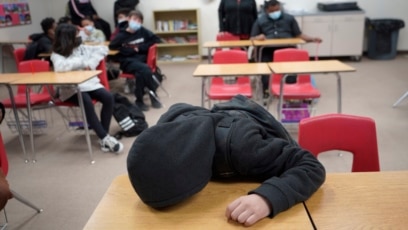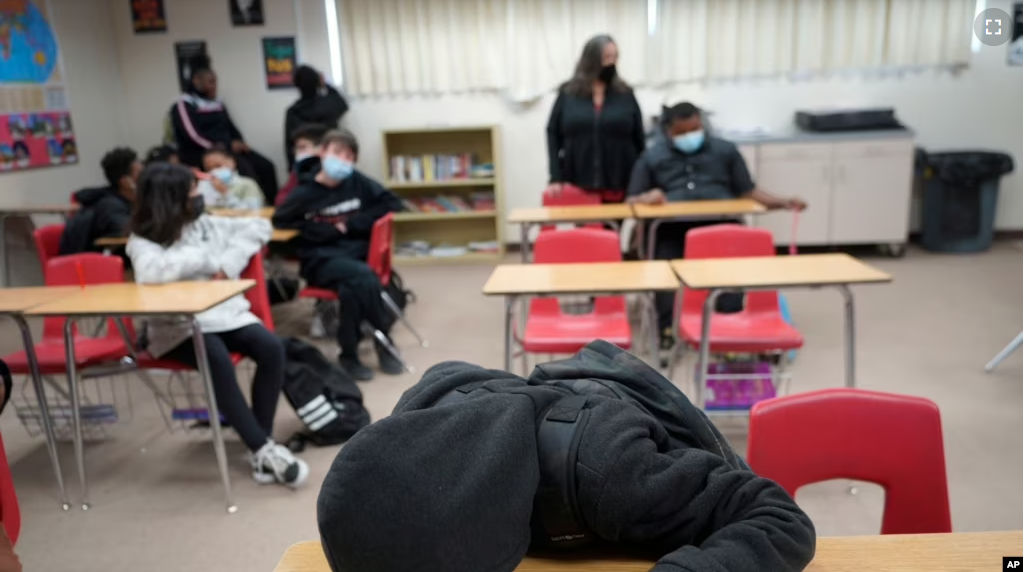American high school students who slept less than seven hours each night during the pandemic were more likely to struggle in school. That finding comes from a recent study from the U.S. Centers for Disease Control and Prevention, or CDC.
The American Academy of Sleep Medicine recommends that teenagers – people between the ages of 13 to 19 — should sleep 8 to 10 hours a night.
For the study, the CDC questioned 7,705 students about their sleep schedules and success in school. More than two-thirds of students said they experienced more difficulty in their schoolwork during the pandemic than before the pandemic. About 75 percent of students did not sleep enough during the pandemic, the study found.
“Students who experienced short sleep duration were more likely to report greater difficulty doing schoolwork during the pandemic than before the pandemic,” the CDC said. Duration is the length of time that something lasts.
Students who reported poor mental health during the pandemic were also more likely to get less sleep. Overall, 37 percent of students said they struggled with their mental health during the pandemic. But about 50 percent of students who slept five hours or less each night said they had poor mental health.
As students recover from learning loss due to the pandemic, schools “can consider including policies and practices known to improve sleep duration,” the CDC said.
Teenagers experience many physical changes when they go through puberty. Puberty also can cause changes in sleep patterns. As children get older, there is a change in their circadian rhythms – the body’s natural clock. Before puberty, children may feel sleepy around 8 or 9 at night. But when they get become teenagers, the body’s clock changes to make them tired much later — around 10 or 11 at night.
Because of this, many teenagers may experience insomnia, or an inability to sleep.
A 2020 study published in the journal Nature found that a consistent sleep schedule can improve test performance.
Students who consistently had good quality sleep were much more likely to do better on tests.
However, “there was no relation between sleep measures on the single night before a test and test performance,” the study found.
Instead, sleep length and quality “for the month and the week before a test correlated with better grades.” The study looked at 100 college students. However, the study’s lead writer said the results could be applied to younger students as well.
Some school systems around the U.S. are pushing back start times for high schools so students can get more sleep.
Usually, high schools start the earliest compared to middle and elementary schools. The National Center for Education Statistics says the average start time for U.S. high schools is 8 a.m. But the American Academy of Pediatrics recommends a start time of 8:30.
The organization Start School Later supports pushing back school start times. It says at least 13,000 school systems in the United States have pushed back start times.
In 2022, California became the first state to require 8 a.m. start times for middle schools and 8:30 a.m. start times for high schools.
The Lower Merion School district outside Philadelphia, Pennsylvania, recently voted to move the high school start time from 7:30 am to 8:40 a.m. The change will take effect in 2024.
In Howard County, Maryland, the school board decided last month to move the high school start time to 8 a.m. starting next school year. Most high schools in the county now begin at 7:25 a.m.
“We have taken a…significant step in the right direction to follow the science, to do what’s best for students,” Howard County board Chair Antonia Watts said after last month’s vote. She said it took two years of discussions to make the change.
Some parents argue that if school starts later, there will be less time for after-school activities. The parents say a later start time would affect their own schedule. A July 2022 survey by the Sleep Foundation found that a little over one-third of parents supported later start times for schools.
The California Teachers Association (CTA) opposed the state requirement. The group argued that even with later start times, students would still need to be dropped off at school at the same time. The time change, it said, would especially hurt working-class families.
A CTA spokesperson told the Los Angeles Times, “there is not enough funding from the state for before school programs to ensure the safety of students who will be dropped off early.”
I’m Dan Novak.
And I’m Caty Weaver.
Dan Novak wrote this story for VOA Learning English.
Quiz – Study: Students Who Slept Less Struggled More in School

Start the Quiz to find out
____________________________________________________________________
Words in This Story
schedule — n. a plan of things that will be done and the times when they will be done
puberty — n. the period of life when a person’s sexual organs mature and he or she becomes able to have children
pattern — n. the regular and repeated way in which something happens or is done
consistent — adj. always acting or behaving in the same way
correlated — adj. to have a close connection with something
apply — v. to use in a particular situation
significant — adj. large enough to be noticed or have an effect
funding — n. an amount of money that is used for a special purpose
